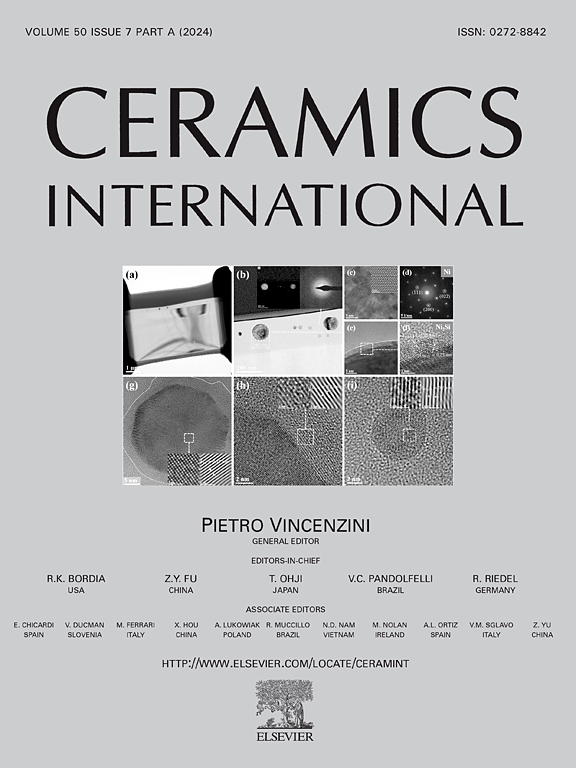优化铌酸镁铋焦绿石作为潜在陶瓷介质:反应过程、相平衡和阻抗特性
IF 5.6
2区 材料科学
Q1 MATERIALS SCIENCE, CERAMICS
引用次数: 0
摘要
相纯Bi2O3-MgO-M2O5 (BMN)立方焦绿石组成范围广,铋含量在41.88 ~ 44.50 mol %之间。四边形亚固体区由两种取代机制定义:(i) Mg2+被Nb5+取代,由氧化学计量变化平衡;(ii) Nb5+一对一取代Bi3+,并由O2−补偿电荷。得到Bi3.36+ mg1.92 - ynb2.72 -x+ yO13.76-x+(3/2)y的通式,涉及两个变量,对应的次立体解极限分别为0.10≤x≤0.20和0.00≤y≤0.16。值得注意的是,这些BMN型焦绿石具有较高的介电常数,在30°C, 1 MHz时ε′在167 ~ 204之间,介电损耗较低,tan δ在10−4 ~ 10−3之间。升高的介电常数可能是由于在焦绿盐结构的关键BO6八面体内Nb2O5的极化性增强所致。此外,这些焦绿石显示负的介电常数温度系数,在30-300℃和1 MHz下,TCε'范围为- 528至- 742 ppm/°C。这些具有高活化能(Ea >1.0 eV)的热稳定性和高绝缘的BMN焦绿石在陶瓷电容器中具有潜在的应用前景。本文章由计算机程序翻译,如有差异,请以英文原文为准。

Optimising bismuth magnesium niobate pyrochlores as potential ceramic dielectrics: Reaction progression, phase equilibria and impedance properties
The phase-pure Bi2O3-MgO-M2O5 (BMN) cubic pyrochlores formed across a broad compositional range, with bismuth content varying from 41.88 to 44.50 mol %. The quadrilateral subsolidus region is defined by two substitution mechanisms: (i) Mg2+ substitution by Nb5+, balanced by oxygen stoichiometry variations and (ii) one-to-one Bi3+ replacement by Nb5+, with charge compensation by O2−. This yields a general formula of Bi3.36+xMg1.92-yNb2.72-x + yO13.76-x+(3/2)y, involving two variables with the corresponding subsolidus solution limits of 0.10 ≤ x ≤ 0.20 and 0.00 ≤ y ≤ 0.16, respectively. Notably, these BMN pyrochlores exhibit high dielectric constants, ε′ in the range of 167–204 at 30 °C, 1 MHz and low dielectric losses, tan δ in the order of 10−4 - 10−3. The elevated dielectric constant is likely due to the enhanced polarisability of Nb2O5 within the crucial BO6 octahedra of the pyrochlore structure. Furthermore, these pyrochlores display negative temperature coefficients of permittivity, TCε' ranging from −528 to −742 ppm/°C at 30–300 °C and 1 MHz. These thermally stable and highly insulating BMN pyrochlores with high activation energies, Ea >1.0 eV, are promising candidate for potential application in ceramic capacitors.
求助全文
通过发布文献求助,成功后即可免费获取论文全文。
去求助
来源期刊

Ceramics International
工程技术-材料科学:硅酸盐
CiteScore
9.40
自引率
15.40%
发文量
4558
审稿时长
25 days
期刊介绍:
Ceramics International covers the science of advanced ceramic materials. The journal encourages contributions that demonstrate how an understanding of the basic chemical and physical phenomena may direct materials design and stimulate ideas for new or improved processing techniques, in order to obtain materials with desired structural features and properties.
Ceramics International covers oxide and non-oxide ceramics, functional glasses, glass ceramics, amorphous inorganic non-metallic materials (and their combinations with metal and organic materials), in the form of particulates, dense or porous bodies, thin/thick films and laminated, graded and composite structures. Process related topics such as ceramic-ceramic joints or joining ceramics with dissimilar materials, as well as surface finishing and conditioning are also covered. Besides traditional processing techniques, manufacturing routes of interest include innovative procedures benefiting from externally applied stresses, electromagnetic fields and energetic beams, as well as top-down and self-assembly nanotechnology approaches. In addition, the journal welcomes submissions on bio-inspired and bio-enabled materials designs, experimentally validated multi scale modelling and simulation for materials design, and the use of the most advanced chemical and physical characterization techniques of structure, properties and behaviour.
Technologically relevant low-dimensional systems are a particular focus of Ceramics International. These include 0, 1 and 2-D nanomaterials (also covering CNTs, graphene and related materials, and diamond-like carbons), their nanocomposites, as well as nano-hybrids and hierarchical multifunctional nanostructures that might integrate molecular, biological and electronic components.
 求助内容:
求助内容: 应助结果提醒方式:
应助结果提醒方式:


